Kwesi Adofo-Mensah had gone two seasons with the quarterback his predecessor signed, but after Kirk Cousins‘ fourth set of Vikings extension talks did not produce a deal in 2023, the current Minnesota GM finally cut the cord. Cousins’ departure headlined an eventful Vikings offseason, one that later included a market-setting wide receiver contract.
As the Vikings transition at quarterback, they will use some of the money freed up by Cousins’ departure — following a not insignificant dead money total stemming from void years — on one of their Rick Spielman-era acquisitions. While Minnesota’s offseason featured notable moves at several positions, the decisions made at quarterback and wideout defined it.
Extensions and restructures:
- Gave WR Justin Jefferson four-year, $140MM extension ($88.7MM guaranteed)
- Reworked S Harrison Smith‘s deal, settling on one-year, $9MM agreement ($7MM guaranteed)
Negotiations between the Vikings and Jefferson ran up to Week 1 last year. At that point, no team in the fifth-year option era (2011-present) had extended a first-round wide receiver with two years of rookie-deal control remaining. Jefferson and CeeDee Lamb were in that boat last year, and while extension rumors surfaced, no deals came to pass. The Vikings submitted an offer worth more than $28MM per year before the 2023 season started. With that proposal not topping Tyreek Hill‘s position-record AAV number, Jefferson predictably declined to set the stage for a 2024 reconvening. The superstar wideout was proven right by waiting.
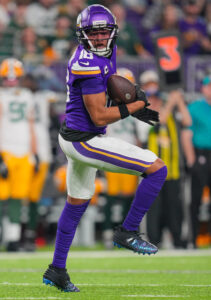 Even though Jefferson sustained a hamstring injury that sidelined him for seven games, he still managed a 1,000-yard season. Jefferson, 25, had already shattered Randy Moss‘ NFL record for receiving yardage through three seasons, accumulating 4,825. Jefferson’s age, his monster production, the Vikings moving off a proven QB’s contract and the receiver market shifting — following a record cap spike — beyond the $30MM place worked in the fifth-year pass catcher’s favor. Jefferson secured whopping terms and returned to work to begin establishing a rapport with Sam Darnold and J.J. McCarthy.
Even though Jefferson sustained a hamstring injury that sidelined him for seven games, he still managed a 1,000-yard season. Jefferson, 25, had already shattered Randy Moss‘ NFL record for receiving yardage through three seasons, accumulating 4,825. Jefferson’s age, his monster production, the Vikings moving off a proven QB’s contract and the receiver market shifting — following a record cap spike — beyond the $30MM place worked in the fifth-year pass catcher’s favor. Jefferson secured whopping terms and returned to work to begin establishing a rapport with Sam Darnold and J.J. McCarthy.
Skipping the start of Vikings OTAs in an effort to become the NFL’s highest-paid non-quarterback, Jefferson succeeded by passing Nick Bosa‘s $34MM-per-year contract. Also possessing leverage stemming from the Vikings’ natural interest in having their top player at workouts to begin training alongside its new QBs, the LSU alum pounced. Jefferson secured record-smashing guarantee figures, prevented the Vikings from backloading his deal the way Hill and Davante Adams‘ contracts are structured and managed this on a four-year agreement — one shorter than the Vikes initially sought.
The fifth wide receiver chosen in a memorable 2020 first round, Jefferson has set guarantee bars that are complicating the Cowboys and 49ers’ negotiations with their 2020 first-round wideouts. His total guarantees ($110MM) checked in $26MM north of A.J. Brown‘s new mark at the position. More importantly, the full guarantees ($88.7MM) are $36MM higher than the next-closest wideout. The WR investment business is booming, and the guarantees the Vikings authorized may give teams pause.
Rumblings about teams considering two-first-rounder trade offers for Jefferson emerged, with the Vikings loosely linked to a trade-up for LSU’s Malik Nabers. Little in terms of concrete info — unlike the Vikes and Giants’ Drake Maye trade-up offers — came out, however. No wide receiver has fetched two first-round picks in a trade since the 2000 offseason saw it happen twice — for Joey Galloway (Seahawks to Cowboys) and Keyshawn Johnson (Jets to Buccaneers) — but after Hill and Adams fetched first- and second-round picks in 2022 swaps, Jefferson’s age and the exploding WR market would have made him a clear candidate to end this drought.
The Vikings have a history of extending receivers and then trading them, having taken this route with Moss (2005) and Stefon Diggs (2020). Minnesota also unloaded Percy Harvin (2013) rather than extend him, but the Adofo-Mensah regime finished the Jefferson process with a commitment.
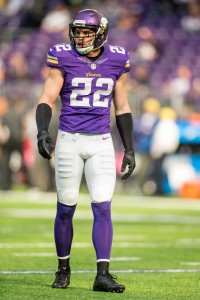 As it stands, the Vikings will pair Jefferson’s megadeal with McCarthy and Jordan Addison‘s rookie contracts. Although Minnesota now has the NFL’s highest-paid wide receiver and tight end (T.J. Hockenson), getting off Cousins’ contract will help the club afford the market-setting accords.
As it stands, the Vikings will pair Jefferson’s megadeal with McCarthy and Jordan Addison‘s rookie contracts. Although Minnesota now has the NFL’s highest-paid wide receiver and tight end (T.J. Hockenson), getting off Cousins’ contract will help the club afford the market-setting accords.
For a second straight year, the Vikings gave Smith a pay cut. The safety market’s inconsistency over the past two offseasons has impacted accomplished veterans. Smith signed two extensions that placed him atop the position’s market — in 2016 and 2021 — but Adofo-Mensah has led the way in back-to-back contract reworkings.
Smith, 35, is the Vikings’ longest-tenured player by a wide margin. He had agreed to a four-year, $64MM extension in August 2021, but after a 2022 restructure, the veteran Pro Bowler agreed to a $7MM pay cut in 2023 and again reduced his deal in March. Smith’s 2021 extension ran through 2025; it now expires a year early, via void years which have become a thorny subject during the Adofo-Mensah regime. Smith reduced a $15.3MM base salary to $9MM, with a $7MM signing bonus representing a solid guarantee for a 13th-year veteran at an unstable position.
Pro Football Focus ranked Smith, whose 176 career games are tied for fifth among defenders in Vikings history, 34th among safeties last season. If Smith is not re-signed before the 2025 league year, the Vikings will be tagged with $9.5MM in dead money. This would remind of Dalvin Tomlinson‘s 2023 exit.
Free agency additions:
- Jonathan Greenard, OLB. Four years, $76MM ($38MM guaranteed)
- Andrew Van Ginkel, LB. Two years, $20MM ($10MM guaranteed)
- Blake Cashman, ILB. Three years, $22.5MM ($9.48MM guaranteed)
- Sam Darnold, QB. One year, $10MM ($8.75MM guaranteed)
- Aaron Jones, RB. One year, $7MM ($7MM guaranteed)
- Shaquill Griffin, CB. One year, $4.55MM ($3.99MM guaranteed)
- Jerry Tillery, DL. One year, $2.75MM ($1.47MM guaranteed)
- Dan Feeney, OL. One year, $1.8MM ($1.38MM guaranteed)
- Trent Sherfield, WR. One year, $1.79MM ($1MM guaranteed)
- Jihad Ward, DL. One year, $1.79MM ($1MM guaranteed)
- Jonah Williams, DL. One year, $1.5MM ($350K guaranteed)
- Robert Tonyan, TE. One year, $1.13MM ($150K guaranteed)
- Kamu Grugier-Hill, LB. One year, $1.38MM ($143K guaranteed)
Not traded for one another, Greenard and Danielle Hunter — PFR’s Nos. 5 and 6 free agents this year — will nevertheless move into each other’s 2023 roles. The Vikings added Greenard early in free agency, doing so before Hunter committed to the Texans. Minnesota showed interest in Bryce Huff but paid more for Greenard. The new Vikings edge rusher’s age (27) works in his favor; he is three years younger than Hunter. The latter has delivered better work, but the Vikings are betting on Greenard’s best NFL stretch being ahead.
 Drafted in Round 3 before Nick Caserio took over as GM, Greenard excelled under both Lovie Smith and then DeMeco Ryans. Greenard had tallied an eight-sack season (in 2021) before an injury-plagued 2022 stalled his early-career momentum. Last season brought new production territory. Ranking 20th with 33 quarterback pressures, Greenard led the Texans in sacks (12.5) despite Will Anderson Jr. winning Defensive Rookie of the Year acclaim and smashed his career-high with 22 QB hits. Greenard ranked sixth among edge rushers in ESPN’s pass rush win rate metric in 2023.
Drafted in Round 3 before Nick Caserio took over as GM, Greenard excelled under both Lovie Smith and then DeMeco Ryans. Greenard had tallied an eight-sack season (in 2021) before an injury-plagued 2022 stalled his early-career momentum. Last season brought new production territory. Ranking 20th with 33 quarterback pressures, Greenard led the Texans in sacks (12.5) despite Will Anderson Jr. winning Defensive Rookie of the Year acclaim and smashed his career-high with 22 QB hits. Greenard ranked sixth among edge rushers in ESPN’s pass rush win rate metric in 2023.
Starting over at OLB, the Vikings need this pace to continue. They still managed to land a 27-year-old edge defender at an upper-mid-market rate. Greenard’s $19MM AAV ranks 15th among edges, though his $38MM guarantee at signing sits eighth. He could certainly reward the Vikings on this deal, especially as the pass rush market — likely via Micah Parsons and a third Myles Garrett contract — moves toward $40MM per year.
A year after moving off the Dalvin Cook contract, the Vikings made a short-term bet on another 2017 RB draftee. Jones does not have the rushing numbers Cook compiled in Minneapolis, but the seven-year Packer is a slightly better receiving option who certainly showed more gas in the tank last season. The Vikings are quite familiar with the versatile back, who closed last season with five straight 100-yard rushing games to propel the Pack to the divisional round, and their interest emerged soon after Green Bay cut bait.
The Packers added a younger back (Josh Jacobs) but one that has not shown what Jones has as an outlet option. After reducing Jones’ pay in 2023, the Packers aimed to cut his wages once again. The sides could not agree on common ground, and the team dropped Jones shortly after the Jacobs deal was finalized. Jones’ Vikings guarantee surpasses Alexander Mattison‘s 2023 number, though not by too much, as the Vikes have one of this era’s best RBs at a midlevel rate.
 The team will bet on the aging (by RB standards) talent having juice left. The 1-A back in timeshares with Jamaal Williams and AJ Dillon in his career, Jones has logged 1,449 career touches. That ranks ninth among active RBs, though the number is close to where Cook’s count stood (1,503) when the Vikings dropped him.
The team will bet on the aging (by RB standards) talent having juice left. The 1-A back in timeshares with Jamaal Williams and AJ Dillon in his career, Jones has logged 1,449 career touches. That ranks ninth among active RBs, though the number is close to where Cook’s count stood (1,503) when the Vikings dropped him.
Jones rounds out an impressive skill-position cadre that includes Jefferson, Addison and Hockenson. This array of weaponry will be available to McCarthy in the long term, but it also could represent (by far) the best options Darnold has worked with as a pro. Brock Purdy enjoyed the 49ers’ unmatched arsenal during Darnold’s San Francisco year; his Jets and Panthers arrays, with Christian McCaffrey largely injured, do not rival what the Vikings possess. Although Darnold has been given plenty of time (56 starts) to show he is a mediocre quarterback, the former No. 3 overall pick chose an interesting opportunity in Minnesota.
Also tied to the Broncos and Commanders, Darnold chose the Vikings. Denver did not make a firm offer, and it is unknown where Washington went. Regardless, Darnold is poised to enter training camp as Minnesota’s starter. Darnold has flashed at points, but for the most part, the USC alum has struggled as a pro. The 27-year-old QB has never ranked higher than 25th in QBR, but he did not have enough snaps to qualify during an intriguing 2022 season in which he helped lead the Panthers back into the playoff race. Granted, this was due to a terrible NFC South, but Darnold averaged 8.2 yards per attempt with a limited Carolina skill corps that season.
It would not surprise to see the Vikings slow-play McCarthy’s climb; this would give Darnold a window to show better form and create a potential starter market for himself in 2025.
 In addition to rebooting on the edge, the Vikes spent midlevel cash to add linebacking help. Van Ginkel can be classified as a hybrid player, having experience on the edge and off the ball. He helped the Dolphins as a rotational rusher and emergency OLB starter last season, compiling six sacks and 19 QB hits.
In addition to rebooting on the edge, the Vikes spent midlevel cash to add linebacking help. Van Ginkel can be classified as a hybrid player, having experience on the edge and off the ball. He helped the Dolphins as a rotational rusher and emergency OLB starter last season, compiling six sacks and 19 QB hits.
The Dolphins drafted Van Ginkel during Brian Flores‘ time in Miami, and he reached 20 QB hits in the current Vikings DC’s South Florida finale (2021). This made the Vikings’ interest unsurprising, and the team’s Cashman move points Van Ginkel to the edge. A rumored Flores-Christian Wilkins reunion did not happen, but the Vikes did not leave free agency without adding one of their DC’s ex-charges.
Cashman will join emerging UDFA Ivan Pace in the Twin Cities, and this payday marks the culmination of a journey that had the ex-Jet as a special-teamer not long ago. Strictly a special-teamer from 2020-21, Cashman still only played 14% of the Texans’ defensive snaps in 2022. But Ryans gave him steady work last year, using him at a 71% snap rate. Cashman notched 106 tackles to eclipse his career-best number by a cool 66, adding nine tackles for loss en route to PFF ranking him as a top-10 ILB regular. The Vikings are giving the Minnesota alum a chance to come home as well, as Cashman grew up in nearby Eden Prairie.
Mentioned as one of the many suitors for franchise-tagged Chiefs cornerback L’Jarius Sneed, the Vikings only exited free agency with Griffin. While Griffin has 79 starts on his resume, two teams — the Jaguars and Texans — cut the soon-to-be 29-year-old CB in 2023. PFF still rated Griffin as a top-50 corner last season, but the former Seahawks mainstay qualifies as more stopgap than difference-maker. As it stands, Griffin has a path to a starting role. The Vikings, as should be expected, are still being tied to seeking CB help.
Re-signings:
- Blake Brandel, G. Three years, $9.5MM ($3.1MM guaranteed)
- David Quessenberry, T. One year, $1.8MM ($1.38MM guaranteed)
- Dalton Risner, G. One year, $2.41MM ($1.1MM guaranteed)
- Jonathan Bullard, DL. One year, $2.25MM ($750K guaranteed)
- Johnny Mundt, TE. One year, $2MM ($750K guaranteed)
- Brandon Powell, WR. One year, $2MM ($625K guaranteed)
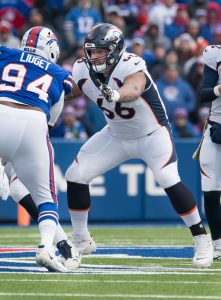 Even as the guard market produced five eight-figure-per-year UFA agreements this offseason, Risner is having a tough time convincing teams he is near that level. A Broncos starter for four seasons, the former second-round pick had not exactly received poor marks from the advanced metrics providers. But Risner has now struck out twice in free agency, waiting into the 2023 season before landing a gig and sitting on this year’s open market until May. Now heading into his age-29 season, the veteran guard is running out of time to cash in. He is sitting on 73 career starts, 11 coming with the Vikings last year.
Even as the guard market produced five eight-figure-per-year UFA agreements this offseason, Risner is having a tough time convincing teams he is near that level. A Broncos starter for four seasons, the former second-round pick had not exactly received poor marks from the advanced metrics providers. But Risner has now struck out twice in free agency, waiting into the 2023 season before landing a gig and sitting on this year’s open market until May. Now heading into his age-29 season, the veteran guard is running out of time to cash in. He is sitting on 73 career starts, 11 coming with the Vikings last year.
Risner made his way into Minnesota’s starting lineup in October 2023, eventually replacing the traded Ezra Cleveland. PFF assigned Risner a mid-pack rating (46th), though ESPN’s pass block win rate metric slotted him ninth among all interior linemen. He will battle Brandel for the Vikes’ left guard gig. Despite having just five starts and just 503 offensive snaps on his NFL resume, Brandel commanded more money than Risner this offseason.
Notable losses:
- Cam Akers, RB
- Anthony Barr, LB
- Kirk Cousins, QB
- Marcus Davenport, OLB
- Josh Dobbs, QB
- Troy Dye, LB
- Jordan Hicks, ILB
- Danielle Hunter, OLB
- Greg Joseph, K
- Dean Lowry, DL (released)
- James Lynch, DL
- Alexander Mattison, RB (released)
- K.J. Osborn, WR
- Chris Reed, G
- Austin Schlottmann, OL
- Khyiris Tonga, DL
- Oli Udoh, OL
- Nick Vigil, ILB
- D.J. Wonnum, OLB
The contracts Cousins and Hunter played out made the Vikings a historical outlier regarding an ability to retain top talent. Minnesota could not use its franchise tag on Hunter due to the parties’ August 2023 reworking, and Washington having tagged Cousins twice made a third tag — which no team has applied since the 2006 CBA made doing so prohibitive — a non-starter. This led to a nine-year Vikings sack ace and the team’s six-year quarterback heading south.
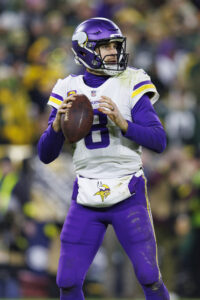 Adofo-Mensah made it work with Cousins in 2022 and ’23, an arrangement that generated a surprise 13-4 season. Cousins sought guarantees into Year 3 during the sides’ 2023 extension talks; the Vikings did not budge. Guarantees remained an issue this year. The fully guaranteed contract Cousins signed in 2018 armed him with leverage in each of his extension talks with the Vikes, leading to guarantee-heavy extensions in 2020 and 2022.
Adofo-Mensah made it work with Cousins in 2022 and ’23, an arrangement that generated a surprise 13-4 season. Cousins sought guarantees into Year 3 during the sides’ 2023 extension talks; the Vikings did not budge. Guarantees remained an issue this year. The fully guaranteed contract Cousins signed in 2018 armed him with leverage in each of his extension talks with the Vikes, leading to guarantee-heavy extensions in 2020 and 2022.
No deal in 2023 pointed Cousins toward the market, and although he expressed interest in staying in Minneapolis on several occasions, the financially savvy QB became a hotshot free agent once again. Cousins doing so ahead of his age-36 season and despite his Achilles tear illustrates the value above-average passers bring when free to negotiate with multiple teams.
The Vikings did make Cousins an offer and upped the guarantees before free agency; it just did not rival where the Falcons went. Ex-Kevin O’Connell Rams coworkers Raheem Morris and Zac Robinson are running the show in Atlanta, and it made sense for the team to chase a stable QB — given the trouble the NFC South club has encountered post-Matt Ryan — with experience in the system Robinson is implementing. The Falcons gave Cousins a $100MM practical guarantee on a four-year, $180MM deal, with locked-in money stretching into 2026 (this agreement produced a tampering penalty). Although Cousins may have reconsidered his path had he known the Falcons would turn around and draft Michael Penix Jr., another $100MM — which will push his career earnings past $330MM — would have been difficult to turn down under any circumstances.
Excluding alternate nods, Cousins has all of one Pro Bowl on his resume. That came under O’Connell in 2022. The Vikings jumping off this ride makes sense, even though it runs the risk of hurting their aerial capabilities this season. But Cousins logged five healthy seasons in Minnesota; the Vikes made the playoffs in two of them. The Vikings won one postseason contest with their affable passer, and while Cousins became the third-longest-tenured QB1 in Vikings history, he offered next to no mobility and has probably delivered his best NFL work. Though, the 12-year vet’s rapport with Jefferson will be difficult for Darnold and/or McCarthy to replicate this season.
Cousins departing after a void years-laden restructure moved $28.5MM in dead money onto Minnesota’s payroll. Dead money issues notwithstanding, the third-year GM used void years once again via more restructures this offseason. No such option was available for Hunter, whose run of contract reworkings stopped after last season.
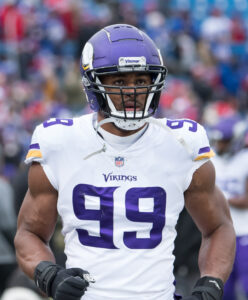 Hunter’s 2023 redo pointed him toward free agency, even though the Vikings did not throw in the towel on keeping him. The Pro Bowl OLB made his first market trip after a career-best season. Hunter saw a borderline-dominant season (16.5 sacks, NFL-most 23 tackles for loss) catapult him into a position in which he commanded a near-fully guaranteed deal from the Texans.
Hunter’s 2023 redo pointed him toward free agency, even though the Vikings did not throw in the towel on keeping him. The Pro Bowl OLB made his first market trip after a career-best season. Hunter saw a borderline-dominant season (16.5 sacks, NFL-most 23 tackles for loss) catapult him into a position in which he commanded a near-fully guaranteed deal from the Texans.
Not long after losing Greenard, Houston guaranteed $48MM of the $49.5MM in his two-year deal. That rare agreement, which will bring Hunter back to the city where he attended high school, came after the former third-round pick reestablished his value following two major injuries.
After a neck injury nixed Hunter’s 2020 season and a torn pec sidelined him for 10 games in 2021, the Mike Zimmer-era third-rounder moved his count of double-digit sack seasons to five. The Vikings depended on Hunter’s bounce-back effort, as their Davenport plan fizzled quickly last year. Davenport’s four-game season led to another “prove it” deal, this one a $6.5MM pact with the Lions.
Although the sack era excludes the famed Purple People Eaters D-line’s work, Hunter leaves Minnesota after racking up the third-most official sacks (87.5) in team history. Wonnum, who became a pivotal edge component due to the injuries the Vikings sustained in recent years, caught a bad break by suffering a torn quad in January. He joined the Panthers on a one-year deal.
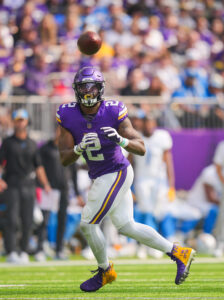 Mattison could not match his off-the-bench production as a starter, averaging 3.9 yards per carry and finishing in the bottom third in rushing yards over expected. The Vikings bailed on a two-year deal, and after ex-fifth-round pick Ty Chandler showed a spark late last season, he promises to mix in as a Jones 1-B.
Mattison could not match his off-the-bench production as a starter, averaging 3.9 yards per carry and finishing in the bottom third in rushing yards over expected. The Vikings bailed on a two-year deal, and after ex-fifth-round pick Ty Chandler showed a spark late last season, he promises to mix in as a Jones 1-B.
Osborn offered slot consistency with Cousins, producing 655- and 650-yard seasons from 2021-22, before finishing with 540 tethered to the Vikes’ gaggle of backups. Osborn did not make sense as a keeper, given the Jefferson payment. That said, the Patriots added the slot regular for just $4MM in March. Osborn’s exit leaves some questions about Minnesota’s WR3 role, with Sherfield (one 400-yard season in six tries) not having offered anything close to Osborn’s consistency.
Minnesota’s kicker from 2021-23, Joseph is now in Green Bay as Anders Carlson‘s top competitor. That represents a step down for the veteran, who kicked in every Vikings game over the past three seasons. Sixth-round pick Will Reichard, Alabama’s kicker for five seasons, is positioned to take over.
Trades:
- Obtained Nos. 23, 232 from Texans for Nos. 42, 188, 2025 second-round pick
Earlier this offseason, it looked like a team that wanted McCarthy would need to complete a notable trade-up transaction to secure necessary real estate. That did not end up being required, but the Vikings acquired more ammo by trading up 19 spots. Minnesota forked over a 2025 second to do so, giving Houston an important future asset. As it turned out, the Vikings used this pick to replace Hunter rather than Cousins. Though, the team made a memorable attempt to climb up for a quarterback.
Draft:
- Round 1, No 10 (via Jets): J.J. McCarthy (QB, Michigan)
- Round 1, No. 17 (via Jaguars): Dallas Turner (EDGE, Alabama)
- Round 4, No. 108: Khyree Jackson (CB, Oregon) (signed)
- Round 6, No. 177 (from Panthers through Jaguars): Walter Rouse (T, Oklahoma) (signed)
- Round 6: No. 203 (from Texans through Browns, Broncos and Jets): Will Reichard (K, Alabama) (signed)
- Round 7, No. 230 (from Falcons through Browns and Cardinals): Michael Jurgens (C, Wake Forest) (signed)
- Round 7, No. 232 (from Broncos through 49ers and Texans): Levi Drake Rodriguez (DT, Texas A&M Commerce) (signed)
With Darnold as the bridge, the Vikings made no secret of their interest in selecting a quarterback in the first round. Adofo-Mensah indicated the team would be comfortable with multiple options, and while Jayden Daniels interest surfaced, the Commanders confirming only one offer came in for their No. 2 pick — presumably from the Daniels-obsessed Raiders — it became clear Minnesota focused its post-Cousins efforts on another passer. Drake Maye what-ifs may follow McCarthy’s career, as the Vikings and Giants made offers to move up to No. 3.
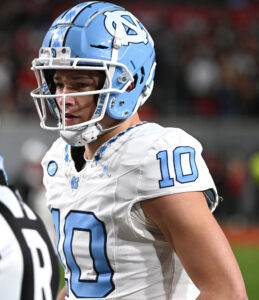 Neither NFC club was able to convince New England to pass on Maye. The Giants proposed Nos. 6 and 47, along with their 2025 first, for No. 3. Competing with this during the early part of the draft, the Vikings are believed to have sent the Pats an offer including Nos. 11 and 23, along with their 2025 first. Minnesota-Maye buzz built before the draft, with New York also enamored with the North Carolina prospect. The Vikings discussed terms with the Cardinals and Chargers, but no move that high became necessary for a player who appeared the team’s Maye backup plan.
Neither NFC club was able to convince New England to pass on Maye. The Giants proposed Nos. 6 and 47, along with their 2025 first, for No. 3. Competing with this during the early part of the draft, the Vikings are believed to have sent the Pats an offer including Nos. 11 and 23, along with their 2025 first. Minnesota-Maye buzz built before the draft, with New York also enamored with the North Carolina prospect. The Vikings discussed terms with the Cardinals and Chargers, but no move that high became necessary for a player who appeared the team’s Maye backup plan.
While the Giants shifted away from the position altogether, the Vikings were effectively pot-committed on adding one of this class’ arms. That turned out to be McCarthy, with a Sean Payton-led smokescreen effort potentially influencing the Vikings to part with a fourth-round pick and moving out of the fifth round (via the Jets) to jump up one spot for their QB hopeful.
McCarthy joined the rest of the top six non-Caleb Williams QB options in visiting Minnesota pre-draft; all but Daniels went through a workout. The Vikings were not closely tied to Michael Penix Jr., so it is not certain if the Falcons’ surprise move affected their plan. McCarthy will be expected to move into Minnesota’s lineup, potentially early in the season.
McCarthy said he spent more time with the Giants pre-draft, but the Vikings made him the first top-10 QB draftee in franchise history. Ownership is believed to have nudged the front office to concentrate on a long-term QB, after its recent year-to-year Cousins plan; that potentially helps explain the trade with the Texans.
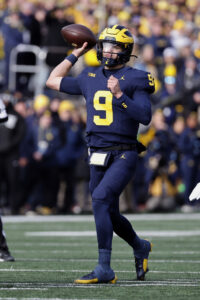 This will give the Vikings a rookie-deal QB starter — once McCarthy takes the baton from Darnold — for the first time since Teddy Bridgewater, and the 2014 first-rounder’s contract (marred by a severe knee injury) finished out with Sam Bradford on the books as well. McCarthy’s deal will give the Vikes a building block, and while teams’ interest in the Michigan prospect may have been exaggerated — as the Jim Harbaugh pupil fell to No. 10 — Minnesota obviously felt comfortable enough to make a pivotal investment.
This will give the Vikings a rookie-deal QB starter — once McCarthy takes the baton from Darnold — for the first time since Teddy Bridgewater, and the 2014 first-rounder’s contract (marred by a severe knee injury) finished out with Sam Bradford on the books as well. McCarthy’s deal will give the Vikes a building block, and while teams’ interest in the Michigan prospect may have been exaggerated — as the Jim Harbaugh pupil fell to No. 10 — Minnesota obviously felt comfortable enough to make a pivotal investment.
Wowing NFL staffers at his pro day, McCarthy was not asked to operate in a high-octane fashion. He attempted 332 passes in each of the past two seasons, reaching that number despite 14- and 15-game campaigns. McCarthy became the rare modern top-10 QB draftee without a 3,000-yard passing season, though his accuracy numbers (72.3% in 2023) impressed. McCarthy averaged nine yards per attempt last season, and his development becomes the central Vikings storyline.
The Vikes also met with Turner pre-draft, and they joined the Colts in benefiting from the draft’s offense-focused start. As a record 14 offensive players started the draft, the top pass rushers fell to the mid-teens. The Colts (Laiatu Latu), Seahawks (Byron Murphy) and Vikings capitalized and addressed their pass rush. Though, Minnesota needed to trade a fifth-round choice and 2025 third- and fourth-rounders to move up six spots. The Vikes had made the Seahawks an offer for No. 16 as well, appearing to emphasize the NFC North team’s interest in pass rushers.
Turner blazed to a 4.46-second 40-yard dash at the Combine, boosting his stock after he followed former teammate Will Anderson Jr. by winning SEC Defensive Player of the Year honors. Turner totaled 10 sacks and 14.5 TFLs during his final Alabama season. The Vikings added some edge options in Greenard and Van Ginkel; Turner becoming a quick study would make this a formidable pass rush.
Other:
- Exercised LT Christian Darrisaw‘s $16.04MM fifth-year option
- Inquired about trade for Chargers QB Justin Herbert
- TE T.J. Hockenson rehabbing January ACL, MCL tears, uncertain to start season on time
- Moved N’Keal Harry from WR to TE
- Hired Josh McCown as QBs coach; OC Wes Phillips issued three-week suspension
- Signed 17 UDFAs
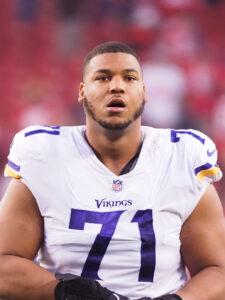 Continuing the trend of Spielman giving Adofo-Mensah building blocks, the former GM’s final first-round pick has become one of the NFL’s best young tackles. ESPN’s run block win rate metric ranked Darrisaw sixth in 2022; Pro Football Focus slotted him second among all tackles that season. PFF graded the Virginia Tech product as the NFL’s eighth-best tackle last season. Understandably, the Vikings are interested in extending Darrisaw. Talks have begun, but the 25-year-old blocker may need to wait.
Continuing the trend of Spielman giving Adofo-Mensah building blocks, the former GM’s final first-round pick has become one of the NFL’s best young tackles. ESPN’s run block win rate metric ranked Darrisaw sixth in 2022; Pro Football Focus slotted him second among all tackles that season. PFF graded the Virginia Tech product as the NFL’s eighth-best tackle last season. Understandably, the Vikings are interested in extending Darrisaw. Talks have begun, but the 25-year-old blocker may need to wait.
Minnesota extended Jefferson going into his fifth year, though the team tried to re-up the 2020 first-rounder last summer. The Vikings getting in early on Darrisaw may matter, as a Tristan Wirfs Buccaneers extension has not happened yet.
Wirfs is likely to eclipse Penei Sewell‘s tackle-record $28MM-per-year number. Rashawn Slater is also now extension-eligible. While Darrisaw does not have the accolades those first-rounders do, he can boost his value with a strong fourth season. The price figures to rise the longer the Vikings wait, but with only Brian O’Neill signed to an upper-crust contract up front, Minnesota should have a salary slot open for a Darrisaw deal.
 Cousins’ lofty dead money sum also impacts the Vikings on the contract front, but the team joined the Patriots in a full-court heave of sorts by asking about Herbert at the Combine. Tied to a $52.5MM-AAV contract, the Chargers standout is now tied to a new regime. Of course, Herbert’s presence played a central role in Harbaugh selecting the Bolts as his vehicle to return to the NFL. It represented a non-starter, though the inquiries make for a fun “what if?” Only two QBs (Deshaun Watson, Jim Plunkett) have been traded for three first-round picks since the merger. Herbert almost definitely would command such a haul, but both Minnesota and New England moved on to rookies.
Cousins’ lofty dead money sum also impacts the Vikings on the contract front, but the team joined the Patriots in a full-court heave of sorts by asking about Herbert at the Combine. Tied to a $52.5MM-AAV contract, the Chargers standout is now tied to a new regime. Of course, Herbert’s presence played a central role in Harbaugh selecting the Bolts as his vehicle to return to the NFL. It represented a non-starter, though the inquiries make for a fun “what if?” Only two QBs (Deshaun Watson, Jim Plunkett) have been traded for three first-round picks since the merger. Herbert almost definitely would command such a haul, but both Minnesota and New England moved on to rookies.
McCown coached Maye when the Tar Heels passer was in high school; the assistant will look to rebound from a rough stint as the Panthers’ QBs coach. Carolina axed the former quarterback shortly after firing first-year HC Frank Reich. McCown, who famously knocked the Vikings out of the 2003 playoffs as the Cardinals’ QB, will be tasked with tutoring another first-rounder after his Bryce Young mentorship featured some complications. Phillips served his three-week ban, stemming from a 2023 DWI arrest, this offseason.
Top 10 cap charges for 2024:
- Brian O’Neill, RT: $22.93MM
- T.J. Hockenson, TE: $14.04MM
- Byron Murphy, CB: $10.91MM
- Harrison Phillips, DL: $8.83MM
- Justin Jefferson, WR: $8.61MM
- Harrison Smith, S: $7.32MM
- Josh Oliver, TE: $6.17MM
- Garrett Bradbury, C: $5.77MM
- Jonathan Greenard, OLB: $5.74MM
- Sam Darnold, QB: $5MM
Darnold and McCarthy working with O’Connell will be interesting, given how Cousins performed in the third-year HC’s offense. After a dormant NFC North period, however, the Vikings are breaking in their new QBs at an interesting point for this division.
The Lions more than justified last year’s hype, delivering their best season since the Bobby Layne years, while the Packers navigated historic Aaron Rodgers dead money to reach the playoffs behind his replacement. With the Bears appearing to upgrade at QB via the Justin Fields-to-Caleb Williams switch and making key WR additions, this division appears deeper. This could result in a Vikings transition year, though the team exceeding expectations under O’Connell in the recent past offers some hope.
JJ McCarthy has Christian Ponder vibes all over him.
Solid 6 win team
This team will be like giving a 15-yo a Maserati. He might have put in a lot of work to drive it, but it’s a lot to handle.
I feel like very few top QBs out of college get a stocked roster since usually a QB draft pick is part of full rebuild. Two top receivers, a top TE, Aaron jones can still contribute in the back and the OL should be better than last year. Even Darnold shouldn’t be able to screw up that offense.
The hard thing for everyone is if the QB decides to move. The team spent years knowing where the ball is snapped to is the spot it will be thrown, handed, tossed from.
Like JJ might look back for a pass and be confused on if it’s even legal for the QB to leave the pocket. The OL might be thrown off that they need to protect someone outside of a 2’ area.
This comment aged so rough. RIP Khyree
The Vikings made a few necessary moves on the second level of the defense, which was very necessary after the losses that they suffered over the tears there. Wonnum looked like the next long term starter that emerged post Everson Griffin, but the injury last year leading out from Minnesota was a significant bump in the road in that regard. Hunter finally leaving the Vikings robbed Minnesota of its other longtime edge leader. To Adofo-Mensah’s credit, he used that first round pick about as well as he could have with Dallas Turner. Griffin and Hunter could have both played as standup linebackers, and Wonnum has done so in both college and the pros at times, but now the Vikings will have two brand new starters in a 3-4 scheme that could be advantageous for Flores.
The downside is, of course, that they will take somd time to be molded into a cohesive unit, but Flores will get to groom Turner into what type of player he wants (or at least get a chance to). I also like the Turner pick over Latu in this case because of the Latu injury unsteadiness. Latu could potentially have a higher ceiling, but Minnesota needed a bit more certainty given how the pick was likely to have to contribute reliably immediately. Greenard was a good signing-I agree with the article that he is mostly potential still even at age 27, but given what was available and how it intersected with the Vikings’ needs and the contract that they got him for, it was a good signing. At 27/28 Greenard hopefully will have his best season, and having a short and relatively low level deal could scrounge that for a market value while Minnesota plans for a younger player to take the reigns opposite (hopefully) Turner.
Flores had to blitz indiscriminately to compensate for his pass rush woes, so changing or adding to the available arsenal was essential for simply making the defense competent enough to not lose games. That 13-4 season still featured the 31st ranked defense in the league, and the inconsistency in pass rush and constant blitzing put immense pressure on the secondary that it could not support. Having a rush reliable enough to operate passively is key to supporting that secondary, which is why the Vikings couldn’t ignore the pass rush losses.
Smith is another player that Minnesota is going to have to plan for. He’s been a real trooper in today’s NFL in terms of accepting pay cuts, because I don’t most players accept them regardless of any circumstance. At 35, he’s a bit like the Vikes’ Cam Heyward in my mind. Smith is still a quality starter, even if he’s not the absolute best safety in the league anymore at this juncture. The best thing with him is that the coach knows that he won’t have to worry about the back end. However, as a rang-y cover safety (Smith can do both spots, and has been asked to do so before), the quality of play of the corners have a big impact on what is demanded of you in terms of having to help and how much needs to be covered. Having boundary corners that can keep up with and isolate enemy receivers really helps ease the burden on the safeties, and Minnesota getting that quality play could improve their safety play as well.
Flores is transitioning fully into his scheme now as many players (Smith notwithstanding) from the last scheme are shed, and we will see if he is able to successfully address the deficiencies in these areas. Van Ginkel is the perfect player for Flores personally because he is so versatile. Van Ginkel is a quality depth piece with certainty and has shown good starter capability, but the real strength is that Flores can plug him in multiple spots and expect that he will know what to do. It’s a good crutch to have in a new scheme.
On offense, I don’t know if I believe much in McCarthy’s ability to be a superstar quarterback, but I don’t know if he necessarily has to be. In an age where teams are riding quarterbacks to franchise accolades at the expense of the other skill position players, Minnesota has established a platoon of offensive weapons that could potentially carry their starter instead. Cousins was, as always, and underrated part of that offense, even with the solidly non-universal praise that he received. Darnold and/or McCarthy are not going to replicate that skill this year. However, the Vikings have what could possibly be the only receiver currently capable of carrying a quarterback on his own (perhaps Hill could as well, but at an older age) in Justin Jefferson. Hockenson is possibly the best receiving tight end in the league, or at least has the potential to be in surpassing mainstays in Kelce and Kittle.
The loss of Osborn I think matters more than most fans immediately will notice, but the Vikings did correct an error last year in not adequately addressing the loss of Cook as a quality starter. Cook of course has slowed down, but it wasn’t letting go that created the gap, but not finding an adequate replacement. Mattison was an okay backup, but going into the year, he didn’t seem like enough to shoulder the load-especially for a team used to a versatile workhorse in Cook. Jobes is aging, but he is extremely versatile and is a more proven starter. That was a good bridge signing to take pressure off the eventual starter. The biggest advantage by far that Jones provides here is his pass catching. That will allow him to operate as a safety valve instead of Hockenson, who go more vertical and allow the Vikings to run more passing sets with their new QB than they could have done otherwise. I’m not saying that they will be a vertical team, mind you, but it does give them more options. Jones is also a great pass protector, and that plays a big role as well.
Risner coming back also bolsters the Vikings’ pass protection, and his lack of a market benefits Minnesota once more. Bradbury isn’t a terrible center, but he and the other guard spot (likely Ingram) could definitely improve in the interior of the line. Risner bailed them out last year, but Cousins had a few scares before ultimately being critically injured in Minnesota, and though the defense was absolutely the biggest issue in costing them wins, the line had issues at times protecting the quarterback. The loss of run game last year contributed to that, of course, as Cousins had to limit his passing options and rushers could attack more freely. O’Neill has been pretty good throughout his career on the right side, but slowed down last year (as did Bradbury) towards the end of the year. A stud tackle in Darrisaw helps, but we’ll have to see if they can be more consistent in protecting Darnold or McCarthy going forward.
Minnesota may have addressed their biggest issue-defensive pressure-this offseason. We’ll see if the complete exchange along the edge to retool to Flores’ preferences will pay off. The offense has enough weapons, but the big question will be how far the Darnold/McCarthy offering will push them. If Jones can stabilize the run game, this will be a much easier question to answer. There’s a lot of new in Minnesota, with the notable exception of Old Man Smith, and it’s hard to say with certainty that it will pay off as anticipated-particularly McCarthy. However, we have to say that Asofo-Mensah certainly was active in addressing his needs. They acquired players where they needed them, and look to have them in the right spots to succeed. The secondary still looks like a work in progress, but most of the growth now seems to need to happen on the field. I think that Adofo-Mensah this year gave O’Connell and Flores tools to work with, which is all you can ask for from a GM. We’ll have to see if he made the right decisions in acquiring them, but if they work out, it’ll be a good start to the new look in Minnesota.